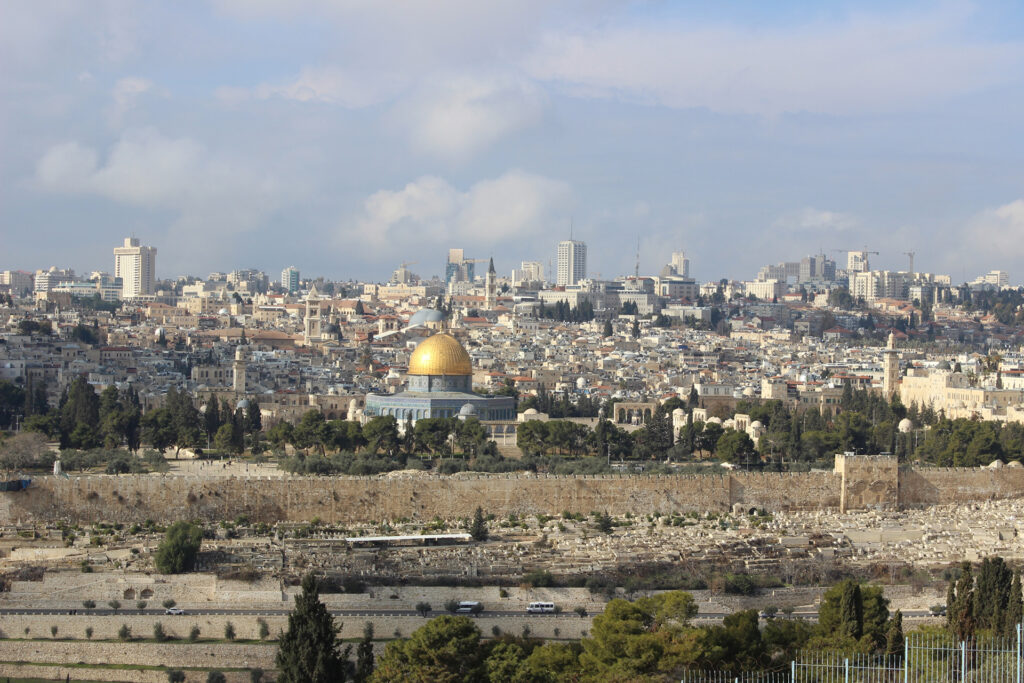The Mount of Olives – also known as Mount Al-Tur – is the highest mountain peak in the city of Jerusalem, and overlooks the blessed Al-Aqsa Mosque. It is distinguished by religious and historical importance for Christians, who believe that it is the site of the ascension of Christ, peace be upon him, to heaven.
Mount Al-Tur is also important because it includes a number of churches and monasteries sacred to different Christian sects.
History and origins
Mount Al-Tur is a series of mountain hills located east of the Old City and adjacent to it. It was called the Mount of Olives after the olive trees that covered its slopes.
Since the fourth century AD, the Mount of Olives has attracted many monks and Christians visiting the Holy Land, and therefore many monasteries and churches that have religious and historical importance were built on it, including:
Monastery of Saint Mary Magdalene
It is a Russian Orthodox monastery characterized by a unique architectural style and golden domes. It was built in the late nineteenth century in honor of Saint Mary Magdalene.
It is located on the western slopes of the Mount of Olives in the city of Jerusalem near the Church of Gethsemane, overlooking the Old City of Jerusalem, and is an important shrine for Christian pilgrims.
The monastery was founded in 1886 in honor of Saint Mary Magdalene, one of the most prominent female figures in Christian belief.
It is distinguished by its beautiful and distinctive architectural design, which includes golden domes and reflects the traditional Russian style. The church inside the monastery is dedicated to Saint Mary Magdalene, and contains beautiful icons and religious decorations.
Carmel Monastery “Our Father”
The Carmelite Monastery is located on the Mount of Olives, near Bethphage and Gethsemane, and opposite the Cenacle and the Church of the Holy Sepulcher. It offers wonderful views of the Old City of Jerusalem, including Al-Aqsa Mosque and the Church of the Holy Sepulcher.
Christians believe that this site is the place where Jesus Christ taught his disciples to pray “Our Father who art in heaven” (the Lord’s Prayer), which is one of the most important prayers in Christianity.
It is said that Empress Helena, the mother of the Byzantine Emperor Constantine, founded a church on this site in the fourth century AD, and that the church was part of a larger complex called the “Byzantine Church.”
In the Crusader era, the original church was destroyed, and it was partially rebuilt during the Crusader period. In 1868, a French duchess named Aurelie de Bussy bought the land believed to contain the holy site and began rebuilding the church.
At the beginning of the twentieth century, the current monastery was built over the remains of the Byzantine church. The building is managed by the French Mission of the Daughters of Carmel.
Inside the “Our Father” Monastery there are plaques bearing the text of the Lord’s Prayer (Our Father) written in more than 140 languages, reflecting the global diversity of Christians.
This monastery attracts pilgrims and visitors from all over the world due to its religious and symbolic importance and its relationship with Christ, peace be upon him.
Monastery of the Ascension (Monastery of Russian Nuns)
A monastery affiliated with the Russian Orthodox Church and inhabited by Russian nuns. It is linked to the incident of the Ascension of Christ, and in its church, which is rich in icons, there is the tomb of the founding monk.
The Ascension Monastery was built in 1870 AD at the top of the mountain near the site of the ancient Church of the Ascension, in the typical new Russian style during the reign of Alexander III.
It was a temple commemorating Empress Maria Alexandrovna, wife of Emperor Alexander II, and it had a church and a 64-meter-high bell tower, one of the highest places in Jerusalem.
The tower’s design abounds with many architectural elements, and has religious connotations dating back to roots much older than monotheistic religions.
Little Galilee Monastery
It is a Greek patriarchal monastery located on the northern side of the Mount of Olives, surrounded by stunning natural scenery. It dates back to the sixth century AD.
The monastery was founded in the Byzantine period, and throughout the ages, it has been subjected to renovations and restorations, especially during periods that witnessed political and religious changes in the region, including the period of Crusader and Ottoman rule.
However, the monastery maintains its spiritual and historical importance in Jerusalem even today. It is one of the places that offers beautiful views of the city and its surroundings. It is also an important place for prayer and meditation visited by many pilgrims and visitors from all over the world.
Monastery of Mercy (Dominus Fleet Church)
The name of the church translates to “The Lord Wept,” and it is believed to be the place where Christ wept over the fate of the city of Jerusalem, and predicted its destruction as he entered it before his crucifixion. The church features a teardrop-shaped architectural design, as if it were a symbol of Christ’s grief over the city. It also provides a stunning panoramic view of the Old City, including the Holy Mosque and the Dome of the Rock.
The Monastery of Mercy is one of the important places for Christians who visit Jerusalem, as it is linked to a sad and important story from the life of Christ.
It was created in 1955 by the famous Italian engineer Antonio Barluzzi, who designed many churches and monasteries in the Holy Land, and has a clear imprint on Christian architecture in that region.
Dominus Velvet Church was built over an archaeological site containing the remains of ancient monasteries and churches dating back to Byzantine times. The site has been considered sacred since the first centuries of Christianity.
Some ancient ruins were discovered during excavations, which confirmed the presence of religious activities in the region dating back to the seventh century AD.

